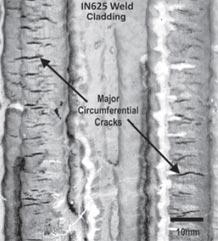Lehigh University
P.C. Rossin College of Engineering and Applied Science
Materials Research for Fossil Energy: Welding
WELDING
Advanced Ultra-Supercritical (A-USC) coal-fired plants will realize efficiency gains and CO2 emissions reductions by operating at up to 760°C. As such, the creep rupture and corrosion requirements for materials in the hottest sections of these new plants will exceed what is attainable by ferritic steels, stainless steels, and most solid solution strengthened Ni-based superalloys. INCONEL® Alloy 740H®, a γ’ strengthened Ni-based alloy has therefore been targeted for this application. However, deleterious microstructural features commonly referred to as precipitate-free or precipitate-denuded zones (shown at right) have been observed along the grain boundaries of alloy 740H weld metal after creep. These denuded zones are locally soft regions within the microstructure and therefore serve as damage accumulation sites which cause a large weld creep strength reduction across a wide variety of creep temperatures and stresses. The objective of this research is to understand the microstructural evolution of alloy 740H fusion welds during creep and establish material and/or processing modifications that can be used to improve the creep performance of welded components.
Microstructural investigation to date has revealed that the γ’-denuded zones in alloy 740H fusion welds evolve due to the influence of four factors: weld metal is more susceptible to the formation of these regions than the base metal because of the microsegregation present in the weld from solute partitioning during solidification, higher creep stresses promote denuded zone formation, as do longer high-temperature exposure times, and higher exposure temperatures. Comparison of the microstructural features associated with the γ’ denuded zones in alloy 740H to the features characteristic of similar regions identified in the literature over the past 60 years has revealed that they are most likely caused by discontinuous coarsening of γ’ at the weld metal grain boundaries. This reaction is driven by the aforementioned solute segregation in the weld metal as well as the motion of grain boundaries via creep deformation and straightening of tortuous weld metal boundaries, and it results in the coarse, elongated γ’ precipitates shown above. One method of mitigating the driving force for the discontinuous coarsening reaction is to reduce the solute segregation in the alloy 740H fusion welds by heat treatment. Thermodynamic and kinetic modeling, verified by experimentally applied heat treatments, have shown that an 1100°C/4hr treatment is sufficient to homogenize the compositional gradients that develop upon weld metal solidification. Current research efforts are focused on understanding the formation of γ’-denuded zones by performing a well-controlled series of thermo-mechanical tests in the Gleeble. This research is being sponsored by Special Metals (through NSF/UCRC); Ohio State University, The Babcock and Wilcox Company, ThermoCalc and ORNL are collaborating partners.
